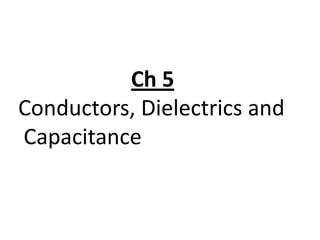Denunciar
Compartilhar

Recomendados
Mais conteúdo relacionado
Mais procurados
Mais procurados (20)
Electric field intensity due to infinite line charge and infinte sheet of charge

Electric field intensity due to infinite line charge and infinte sheet of charge
Electricity & Magnetism Conceptual Physics acloutier copyright

Electricity & Magnetism Conceptual Physics acloutier copyright
Destaque
It is very useful for Electrical &Electronics and Electronics and Communication Engineering Students. Here explained the all types of Electrical and Electronics instruments with relevant diagram and EquationsMeasurements and Instrumentation - Electrical and electronics instruments

Measurements and Instrumentation - Electrical and electronics instrumentsJCT COLLEGE OF ENGINEERING AND TECHNOLOGY
Destaque (16)
Electromagnetic field - (force & field) Static Electricity 

Electromagnetic field - (force & field) Static Electricity
Measurements and Instrumentation - Electrical and electronics instruments

Measurements and Instrumentation - Electrical and electronics instruments
EMT/EMR INTRODUCTION TO EMS & RESEARCH POWERPOINT TRAINING MODULE

EMT/EMR INTRODUCTION TO EMS & RESEARCH POWERPOINT TRAINING MODULE
Semelhante a Emt ch 5
Semelhante a Emt ch 5 (20)
Diploma sem 2 applied science physics-unit 3-chap-1 band theory of solid

Diploma sem 2 applied science physics-unit 3-chap-1 band theory of solid
B.tech sem i engineering physics u ii chapter 1-band theory of solid

B.tech sem i engineering physics u ii chapter 1-band theory of solid
Class 12th Solids and semiconductor devices part 1

Class 12th Solids and semiconductor devices part 1
B.Tech sem I Engineering Physics U-II Chapter 1-Band theory of solid

B.Tech sem I Engineering Physics U-II Chapter 1-Band theory of solid
Mais de rizwankhan583
Emt ch 5
- 1. Ch 5 Conductors, Dielectrics and Capacitance
- 21. Let us see what happens a number of electrons are placed on the interior of a conductor . The electric fields set up by these electrons will repel each other and accelerate away from each other. Finally these electrons will reach to the surface of the conductor. The two characteristic of a good conductor are as under. 1 No charge may remain within the conductor. As a final result zero charge density with in the conductor and a surface charge density resides on the exterior surface. 2 For the static conditions, no current flows and this leads that the electric field intensity within the conductor is zero. If it were not zero then it may apply a Force on the electron in valence band and may constitute a current.
- 31. 1 Two types of current carriers are present, electrons and holes. 2 Holes are considered as positive charge carriers with μh. 3 Electron with mobility of μe. 4 Both the carrier move in the opposite direction in electric field but constitute the current in same direction. 5 The conductivity is therefore a function of both hole and electron concentration and motilities.
- 34. P modify the E field in the magnitude and direction. The charge displacement in the form of dipole ,store energy that is useful in the construction of capacitor. A conductor with finite conductivity will have a polarization. A dielectric in an electric field can be viewed as a free-space arrangement of microscopic electric dipole composed of +ive and –ive charges whose center don't coincide. Dipole charges are not free charges and don’t contribute to the conduction process. Dipole are considered as a source of electrostatic field. All the dielectric materials store electric energy whether they are solid, liquid or gases and whether or not they are crystalline in nature. Polar molecules have a permanent displacement between the center of gravity of +ive and _ive charges.
- 37. We first consider the tangential component of electric field using the relation